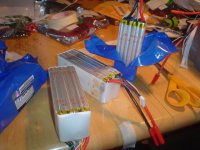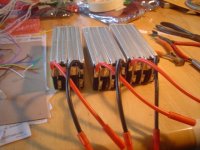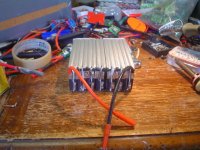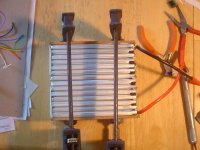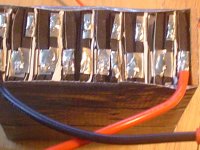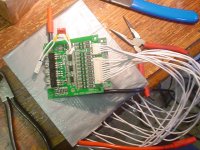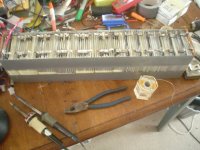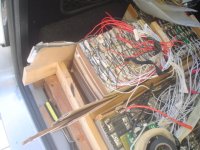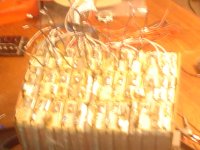macribs
10 MW
- Joined
- Jul 22, 2014
- Messages
- 3,702
Getting batteries from HK seems like a marathon. The sheer numbers alone make it daunting trying to a feeling of what to choose from. There are various Names, brands, and even qualities of each brand. Sometimes what sets them apart is apparent other times not so much.
To put thing in context I will be running QS 205 v3 / Adaptto maxi or Sabvoton. I consider running 22s. p depends on cash flow.
So there more then a few 6s 5Ah batteries to choose from. We can see they vary in C - rating. From 20C upwards to peak of 130C.
Will I notice any real life difference between a pack made from flightmax 20 C or flightmax 60 C?
Are the claims of more then 130 C even real?
How high C rating do I really need? For repeated full throttle accelerations until battery is empty?
I would love to hear from people that have used various batteries from HK and that know how to spot the good deals over the hyped ones. As the price per brick varies with close to 100 $ from the most expensive to the cheapest one it is important to know what to choose so one does not throw away good money on something that might just be a paper spec for spec wankers.
--------------------------------------------------------------------------------------------------------------------------------------------------------------------------
Edited 19th of January 2016.
Today I made my choice of battery chemistry and I owe that to Allex. Here is what he wrote and what convinced me to drop Lipo from HK and go for 18650's.
Wow that was a compelling argument you made. I don't think I ever have looked at the like this before. Well you just got me hooked Allex. 18650 it is.
Off to learn about spot welding, pack design, strip size and so much more......sigh a little overwhelmed right now, big task ahead for one uneducated old timer new to the world of electric, physics and electrons.
To put thing in context I will be running QS 205 v3 / Adaptto maxi or Sabvoton. I consider running 22s. p depends on cash flow.
So there more then a few 6s 5Ah batteries to choose from. We can see they vary in C - rating. From 20C upwards to peak of 130C.
Will I notice any real life difference between a pack made from flightmax 20 C or flightmax 60 C?
Are the claims of more then 130 C even real?
How high C rating do I really need? For repeated full throttle accelerations until battery is empty?
I would love to hear from people that have used various batteries from HK and that know how to spot the good deals over the hyped ones. As the price per brick varies with close to 100 $ from the most expensive to the cheapest one it is important to know what to choose so one does not throw away good money on something that might just be a paper spec for spec wankers.
--------------------------------------------------------------------------------------------------------------------------------------------------------------------------
Edited 19th of January 2016.
Today I made my choice of battery chemistry and I owe that to Allex. Here is what he wrote and what convinced me to drop Lipo from HK and go for 18650's.
Allex said:This is LiPo thread, but ok we can do a comparison.
If we take one of the best 18650 in terms of energi density (Sanyo GA 3,6V 3,5Ah) we get that you can fit:
GA 12.6Wh 18x650mm total: 16.54CC 0,76Wh/cm3
0,76Wh per cubic centimeter
Then we can take the new and popular Multistar High Capacity 4S 8000mAh we get that you can fit:
MS 118,4Wh 142x49x43mm total: 299.194cc 0,4Wh/cm3
0,4Wh per cubic centimeter
How about Wh/kg?
GA:
12,6Wh/45g=0,28wh/g or 280Wh/kg
Multistar Lipo:
118.4Wh/643g=0,184wh/g or 184Wh/Kg
Same thing here, you get 96Wh more or less for each kg
And its is up to you to decide weather it is worth to carry 2kg of 560Wh or 2kg of 368Wh
But lets take those popular hard case packs, they are really horrible in terms of power density and you can almost compare them to Lead acid when taking 18650 into account
http://www.hobbyking.com/hobbyking/store/__26801__Turnigy_5000mAh_4S1P_14_8v_20C_Hardcase_Pack_UK_Warehouse_.html?strSearch=turnigy%20hardcase
These babies have 0,268wh/cm3 or 140Wh/Kg
Wow that was a compelling argument you made. I don't think I ever have looked at the like this before. Well you just got me hooked Allex. 18650 it is.
Off to learn about spot welding, pack design, strip size and so much more......sigh a little overwhelmed right now, big task ahead for one uneducated old timer new to the world of electric, physics and electrons.



